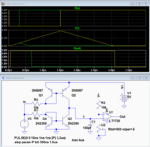Follow along with the video below to see how to install our site as a web app on your home screen.
Note: This feature may not be available in some browsers.
What is the minimum time between the falling edge of the one pulse to the rising edge of the following pulse?
What frequency or repetition rate is involved?
The feasibility of this depends on the range of pulse widths.
But how about an up/down counter that counts up during the pulse duration, then counts back down ?
This is going to take more than a bit of "simple" logic.
How accurate does the "twice" have to be and what resolution is required?
That will determine the circuit complexity required.
It certainly won't be "simple".
300nS is too fast for the up/down counter approach.Would you teach me how to do it? The pulse width will be around 300ns and above, not necessarily exact twice.
This would be also my solution. An accuracy of e.g. 1 % of the pulse period (about 20 ns) should be achievable with regular analog design, even ns range with really fast components. On the other hand, 5 or 10 ns ís no problem with standard programmable logic, could think of a single chip solution with a recent flash based FPGA.I was thinking about a bidirectional current source charging/discharging a capacitor with a comparator that trips near the zero point, but that may be too slow as well. This way the you get double the pulse width with a small error.
The capacitor charge/discharge most stay in a small (approximately) linear part of the exponential curve. Otherwise the intended fixed pulse width relation can't be achieved. It's better to use current sources.A simple DCR arrangement works (approximately) if duty cycle is short. The capacitor and potentiometer values are determined by experimentation. The aim is to adjust capacitor charge/discharge so it goes above 2.5 V for a portion of the cycle which is proportionate to pulse length.
